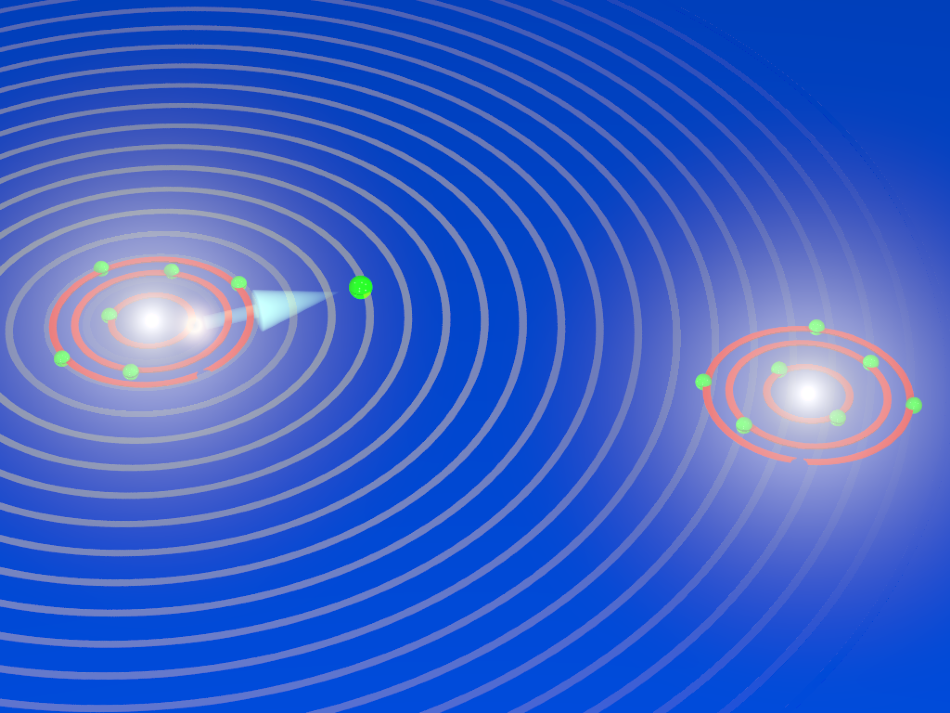Jun 10 2020
For over two centuries, X-rays have been predominantly used to peer inside matter, and continue to advance to increasingly smaller structures—right from crystals to nanoparticles.
 During the explosion of an oxygen molecule: the X-ray laser XFEL knocks electrons out of the two atoms of the oxygen molecule and initiates its breakup. During the fragmentation, the X-ray laser releases another electron out of an inner shell from one of the two oxygen atoms that are now charged (ions). The electron has particle and wave characteristics, and the waves are scattered by the other oxygen ion. The diffraction pattern is used to image the breakup of the oxygen molecules and to take snapshots of the fragmentation process (electron diffraction imaging). Image Credit: Till Jahnke, Goethe University Frankfurt.
During the explosion of an oxygen molecule: the X-ray laser XFEL knocks electrons out of the two atoms of the oxygen molecule and initiates its breakup. During the fragmentation, the X-ray laser releases another electron out of an inner shell from one of the two oxygen atoms that are now charged (ions). The electron has particle and wave characteristics, and the waves are scattered by the other oxygen ion. The diffraction pattern is used to image the breakup of the oxygen molecules and to take snapshots of the fragmentation process (electron diffraction imaging). Image Credit: Till Jahnke, Goethe University Frankfurt.
Within the context of a bigger international association on the X-ray laser European XFEL based in Schenefeld close to Hamburg, physicists from Goethe University have now made a major breakthrough. For the first time, they were able to “X-ray” molecules such as oxygen and observe their movement in the microcosm using a novel experimental method.
“The smaller the particle, the bigger the hammer.” This law from particle physics, which peers inside the interior of atomic nuclei through large accelerators, also applies to this latest study.
However, an ultra-short and highly powerful X-ray pulse is needed to “X-ray” a two-atom molecule such as oxygen. This requirement was met by the European XFEL, which began its operations in 2017 and is one of the strongest X-ray sources in the world.
A new X-ray method is also required to reveal individual molecules. Using the highly powerful laser pulse, the molecule is rapidly robbed of a pair of firmly adhered electrons. This results in the formation of a pair of two positively charged ions that quickly fly apart from one another because of the electrical repulsion. The fact that electrons act just like waves is also exploited.
You can think of it like a sonar. The electron wave is scattered by the molecular structure during the explosion, and we recorded the resulting diffraction pattern. We were therefore able to essentially X-ray the molecule from within, and observe it in several steps during its break-up.
Till Jahnke, Project Manager and Professor, Institute for Nuclear Physics, Goethe University Frankfurt
For this method, referred to as “electron diffraction imaging,” physicists at the Institute for Nuclear Physics devoted many years to further improve the COLTRIMS method, where it was originally conceived (and is usually known as a “reaction microscope”).
Under the guidance of Dr Markus Schöffler, a matching apparatus was altered to suit the needs of the European XFEL beforehand. This apparatus was developed and realized in the course of a doctoral thesis undertaken by Gregor Kastirke.
It was not an easy job, as Professor Jahnke observed: “If I had to design a spaceship in order to safely fly to the moon and back, I would definitely want Gregor in my team. I am very impressed by what he accomplished here.”
Published in the current issue of the leading Physical Review X journal, the result demonstrates for the first time that this kind of experimental technique actually works. In the days to come, these images with their high temporal resolution can be used to analyze photochemical reactions of individual molecules.
For instance, the reaction of a medium-sized molecule to UV rays could be observed in real-time. Moreover, these are the first measurement outcomes to be published since the beginning of the operations of the Small Quantum Systems (SQS) experiment station based at the European XFEL at the end of 2018.
Journal Reference:
Kastirke, G., et al. (2020) Photoelectron Diffraction Imaging of a Molecular Breakup Using an X-Ray Free-Electron Laser. Physical Review X. doi.org/10.1103/PhysRevX.10.021052.